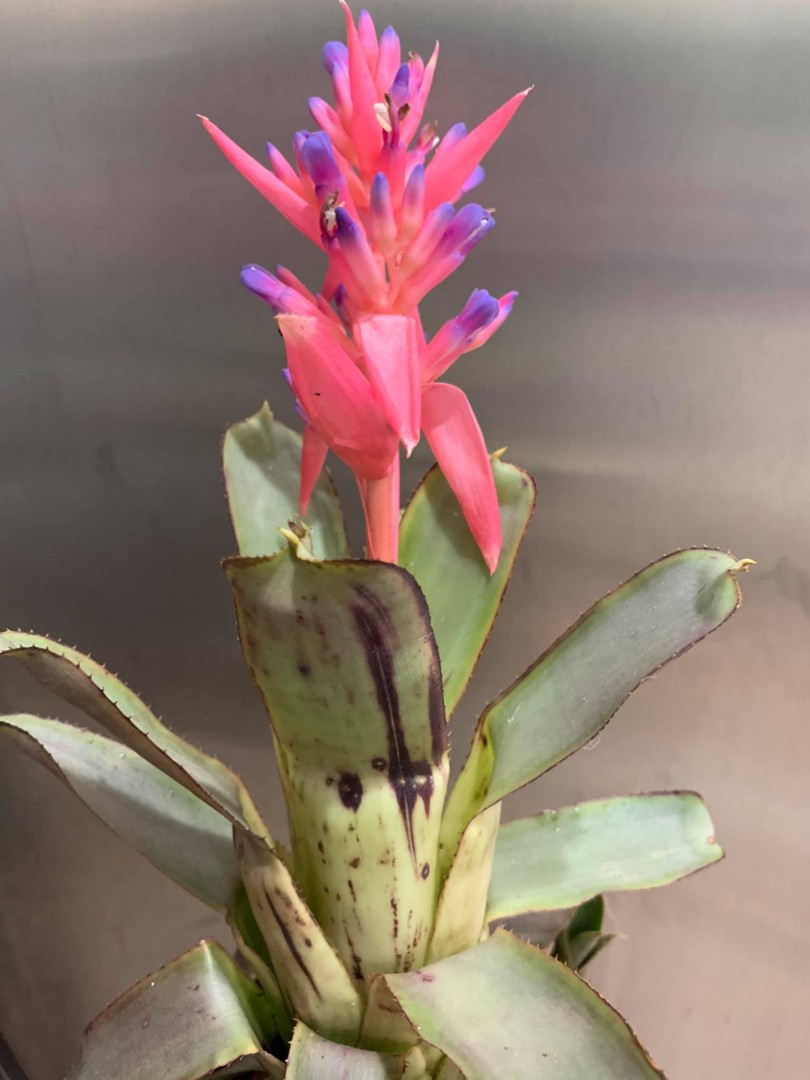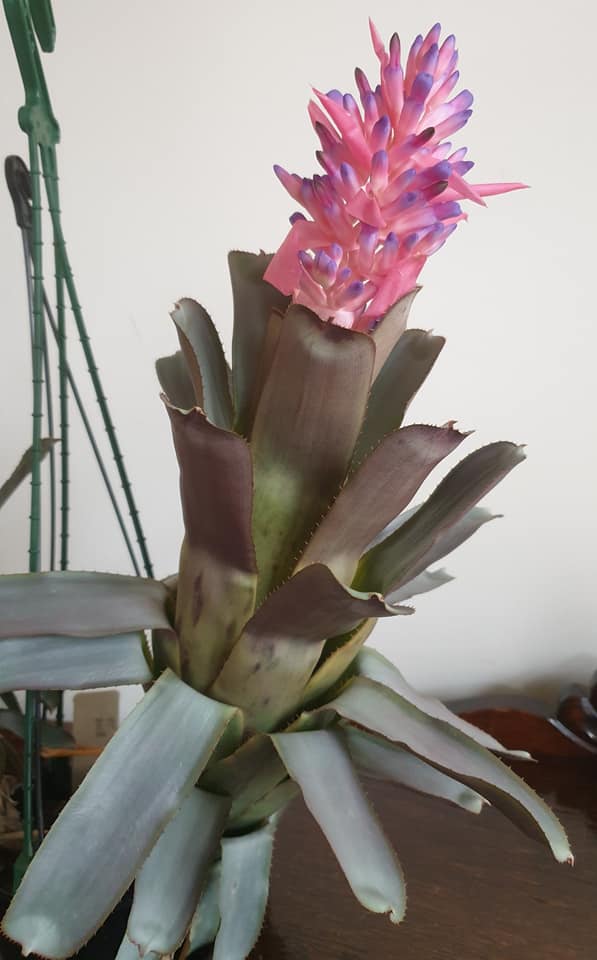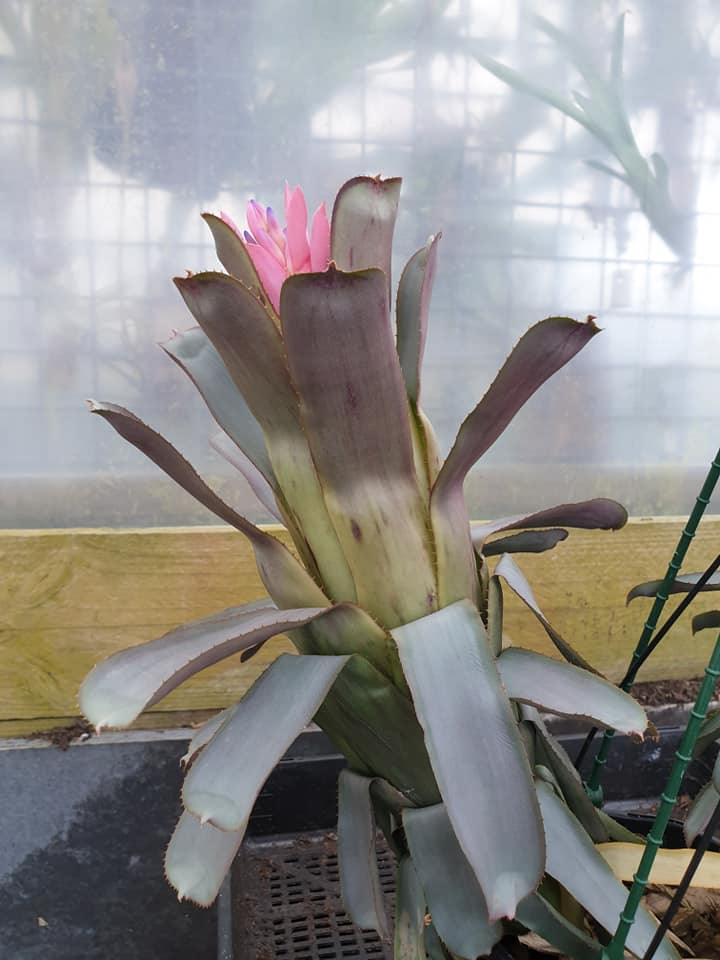


Plant flowering ca 38cm high, stoloniferous:
Leaves ca 20, rosulate, forming a tubular utriculum at the base.
Sheaths narrow sub-oblong, 13-16cm long, 4.5-5cm wide, erect, inside up to the middle dark purple, outside green, both sides dense minute brown lepidote.
Blades oblong or short sub-linear, 7-9cm long, 3-3.7cm wide, both sides dense but very inconspicuous white lepidote, green, thick, abruptly sub-erect or reflexed, tip obtuse and apiculate, edges subdense spinulose, spines ca 1mm long.
Scape erect, ca 20cm long, ca 6mm diam, pinkish, primarily inconspicuous white lanuginose
Scape bracts long, elliptic-lanceolate, tip acute and apiculate, 5cm long, 1.7cm wide, membraneous, rosy, entire or near the tip very remotely spinulose, inside glabrous, outside very inconspicuous sparse white lepidote, scales fimbriate, bottom ones shorter than the internodes, upper ones near the inflorescence exceeding the internodes, reflexed.
Inflorescence compound, bipinnate toward the base, erect, subdense, ca 9cm long, ca 4.5cm diam., exceeding the height of the leaves.
Primary bracts similar to the scape bracts but shorter, entire, 3-4.5cm long, equalling the height of the branches or a little exceeding, reflexed,
Branches ca7, 2.5-4cm long, suberect, 3-6 flowered, subdense flowered, rhachis geniculate,
Floral bracts very small, triangular, acute, ca 2cm long, rosy
Flowers 22-27mm long, sessile, distichous on the branches or in the simple part polystichous,
Sepals very asymmetric, with a rounded membranaceous wing above the central part tip, blunt, subobtuse, ecarinate, free, rosy, purple toward the tip, glabrous, 11mm long,
Petals spathulate, tip emarginate-cucullate, 18-21mm long, ca 7mm wide, violet, afterwards red, at anthesis erect, towards the top edges undulate, at the base 2 denticulate ligules ca 2mm long,
Stamens included, Filaments towards the top clearly complanate-dilatate, ca 2mm wide, epipetalous ones totally adnate to the petals, episepalous ones free, Anthers 5mm long, linear, sagittate at base, tip obtuse, dorsifixed toward the middle, Epigynous tube 1mm long, placenta near the base joined to the tip of the locules,
Ovules many, obtuse.
Type: Brasil, State of Bahia, Caceres. Leg. Alvim Seidel 1132 (=1121). Flowered in cultivation December 1989 Holotype (HB)
This new species links closely with Quesnelia marmorata (Lemaire) R.W.Read that happens in states of São Paulo, Rio of Janeiro and Espírito Santo. They differ in the rosulate disposition of the leaves, whose blades are totally green and abruptly stand out, also in relationship to the erect sheath, compared to suberect to reflexed, as well as for the inflorescence more densely flowered and for the obtuse and free sepals.
Notes on Quesnelia alvimii, a distinct species by Elton M. C. Leme in Journ Brom Soc 51(6): 244-246. 2001
Quesnelia alvimii Leme was described in 1991 on the basis of a specimen collected and cultivated by Alvim Seidel, the owner of Orquiderio Catarinense, at Santa Catarina, Brazil. In April 1989, Seidel wrote a letter to the author and added a photo, calling attention to this unusual species and emphasizing that there was just one mature plant that would provide pups soon. According to the information provided by the collector in the letter, it came from Caceres, Mato Grosso State. Checking my old files, I found the photo numbered 1121 on the back by Seidel's hand, which portrayed a blooming specimen and a nearly adult sterile plant, both in the same pot. On December 1989, Seidel finally mailed a living blooming plant, which was certainly that nearly adult sterile specimen pictured in that photo.
Although the mailed specimen was the same previously identified in the photo numbered 1121, Seidel re-numbered it as 1132, stating that it came from Bahia. So in the protologue the type-specimen was identified as follows: "State of Bahia, Caceres, Leg. Alvim Seidel 1132 (= 1121), flowered in cultivation in December 1989" (Leme,1997). The State of Mato Grosso previously listed was not mentioned simply due to author's mistake. On the other hand, Seidel's bromeliad specimens can easily be understood. He gives a different sequential number for any plant, part of plant or related material (e. g., photo) just based on the date of postage. His sequential numbers have no correspondence to place or date of field collection which would explain occasional lapses in naming sites of origin.
In the protologue, Q. alvimii was considered a close relative to the well known Q. marmorata. The differences then mentioned were the rosulate arrangement of the leaves, with blades green throughout and abruptly suberect to reflexed in comparison to the erect sheaths. Other explicitly indicated differences were the congested inflorescence and the obtuse and free sepals.
Recently, when revising the species of Quesnelia in Rio de Janeiro State, Vieira (1999) proposed the inclusion of Q. alvimii as a synonym of Q. marmorata. She considered the characteristics reported to Q. alvimii to be covered by the range of variation of some populations of Q. marmorata. However, Q. alvimii is one of those species which can easily be recognized and distinguished from its closest relative (i.e., Q. marmorata), even when sterile, without consulting keys or descriptions, being then in accordance to practicality and clear characters which are the basic ideas behind Linnaean taxonomy. It is amazingly different due to the unusual combination of leaf and inflorescence conformation, in addition to the color of the plant itself, as indicated in its original description.
Once, Lyman B. Smith did not agree with Edmundo Pereira concerning the distinct identity of Aechmea flavo-rosea in comparison to A. caesia. He then wrote: "Don't be confused if botanists disagree - it is only normal" (apud Padilla, 1980). The situation here is similar. The very detailed Quesnelia revision accomplished by Vieira (1999), besides its striking amount of new taxonomic information, remind us about the need to revise some obscure aspects of recently and poorly known Brazilian species, mainly those based on Seidel's imprecise records gathered after 1980 (e. g. Aechmea pseudonudicaulis, A. seidelii, A. seideliana, Quesnelia alvimii, Cryptanthus dianae, Vriesea weberi). Two main aspects should be urgently addressed: a) investigation of the possible natural or accidental, interspecific or even bigeneric hybrid nature of Seidel's species, as demonstrated for some Nidularium recently transferred to nothogenus XNiduregelia (Leme, 2000); b) promotion of a field survey trying to locate wild populations and the real place of collection of those taxa.